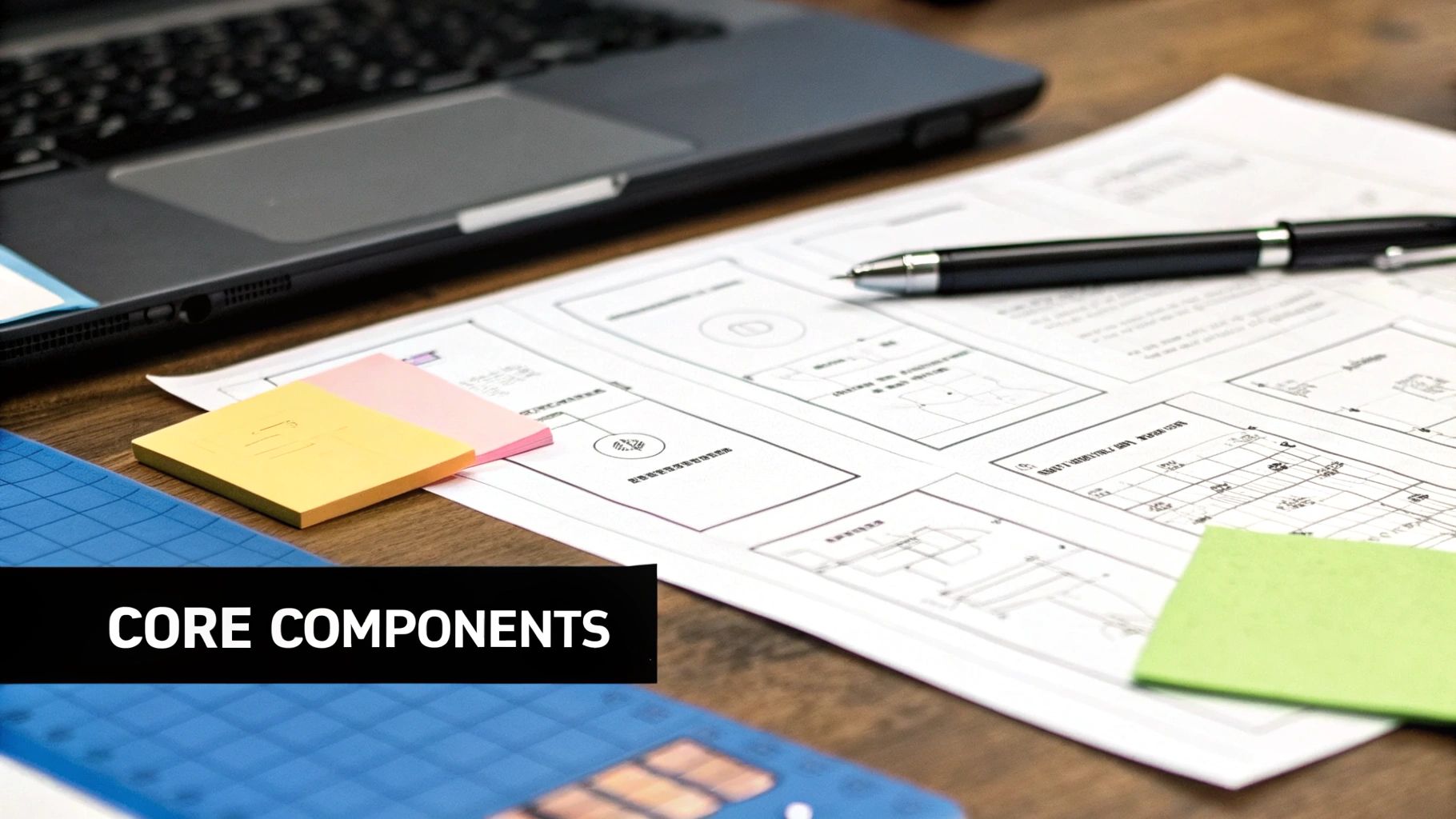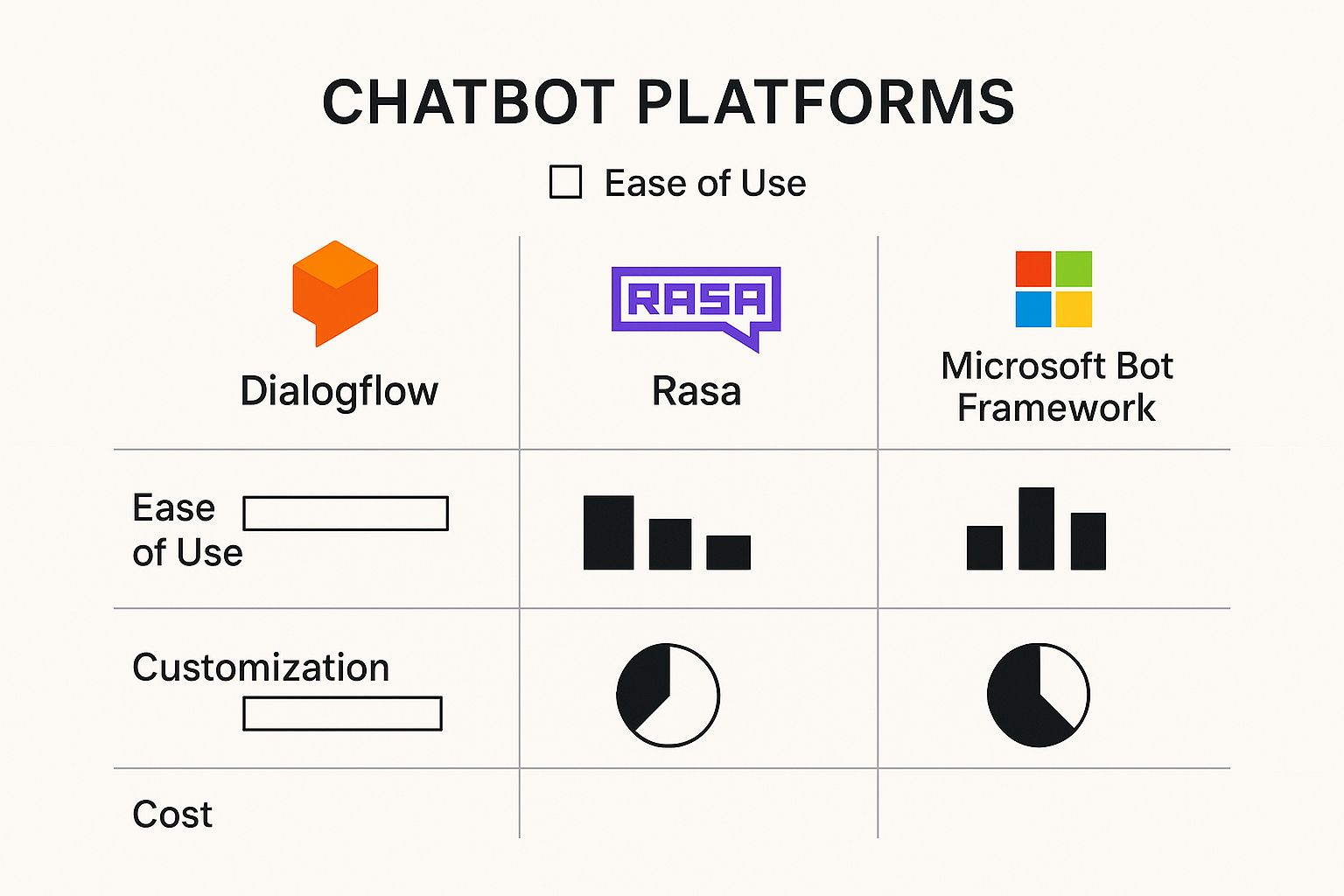build your own chatbot
AI assistant creation
conversational AI
chatbot development
custom bots
Build Your Own Chatbot: A Quick & Easy Guide
The Evolution of Chatbot Technology: What's Possible Now

Building a chatbot today is a vastly different process than it was just a few short years ago. Early chatbots depended on rule-based systems, essentially pre-programmed decision trees. These systems could manage simple questions and tasks, but struggled with anything outside their defined parameters, often leading to frustrating dead ends for users. Think of them like automated phone menus: helpful in specific situations, but ultimately inflexible.
However, the arrival of Artificial Intelligence (AI), especially in Natural Language Processing (NLP) and Generative AI, has dramatically changed chatbot capabilities. Now, building your own chatbot means creating a conversational agent that can understand and respond to user input with a level of nuance previously impossible. AI-powered chatbots can analyze the subtleties of language, comprehend user intent, and even create text in various formats.
This shift has led to more natural and engaging interactions, creating exciting new opportunities for both businesses and developers.
Three Distinct Approaches to Chatbot Development
There are now three primary ways to build a chatbot:
-
Rule-Based Chatbots: These systems still have a place for specific use cases, particularly in highly structured environments. They’re excellent for simple FAQ bots or automated ordering systems where user interactions follow predictable paths.
-
AI-Powered Chatbots: These chatbots utilize NLP and generative AI to create dynamic and engaging conversations. They can understand complex questions, learn from user interactions, and adapt their responses. This makes them well-suited for personalized experiences or complex customer service inquiries.
-
Hybrid Chatbots: This approach combines rule-based and AI-powered systems. By implementing rules for specific tasks and using AI for more open-ended conversations, hybrid chatbots offer a strong balance of efficiency and flexibility. This is a valuable option for businesses needing both structured procedures and dynamic interaction.
This significant advancement is reflected in the predicted growth of the chatbot market. The global chatbot market is expected to reach $9.56 billion by 2025, growing from $7.76 billion in 2024. Business adoption of AI-powered chatbots is projected to rise by 34% in 2025, propelled by these advanced AI features. For further statistics, see: Discover more insights about chatbot statistics. This rapid expansion highlights the growing importance of chatbots across diverse industries.
Selecting the right approach depends on various factors, including your specific business needs, technical expertise, and resources. Understanding the advantages and disadvantages of each method is essential for making informed decisions aligned with your project goals. In the following sections, we will examine these factors in more detail, equipping you with the information you need to build your own chatbot successfully.
Defining Your Chatbot's Purpose: From Concept to Reality

Building a successful chatbot begins with a clear purpose. This initial planning stage is critical, yet often overlooked. Without a well-defined objective, your chatbot project risks becoming irrelevant and ineffective. This section guides you through the essential steps of defining concrete goals, establishing a unique personality, and setting realistic expectations.
Identifying Your Business Goals
Before diving into development, pinpoint the specific business challenges your chatbot will address. What problems are you trying to solve? Are you aiming to improve customer support, generate leads, or automate internal tasks?
Clearly defined objectives will inform your development decisions and ensure your chatbot provides tangible value. For instance, a chatbot designed for lead generation should prioritize qualifying potential customers by asking targeted questions and efficiently gathering data.
This differs significantly from a customer support chatbot, which focuses on resolving issues and providing helpful information quickly and effectively.
Crafting a Conversational Style
Your chatbot's personality is just as important as its functionality. It's the voice of your brand and directly influences user experience. Think about the tone and style that best represents your brand identity.
Will your chatbot be friendly and informal, or more professional and informative? A consistent conversational style cultivates trust and promotes engagement. Also, consider your target audience. A chatbot designed for teenagers will communicate differently than one designed for business professionals.
This extends to the chatbot's overall “voice.” Should it be playful and humorous, or direct and efficient? The language and tone should align with your target audience and reinforce your brand image.
A noticeable shift in consumer preferences indicates a growing preference for chatbot interactions. 62% of consumers prefer engaging with a chatbot rather than waiting for a human agent, and 87.2% report neutral or positive experiences. This preference stems from improved efficiency. Chatbots can manage approximately 70% of conversations from start to finish, reducing costs by up to 30% and response times by 80%. Developing your own chatbot allows you to tailor this technology to your specific customer needs, boosting satisfaction. Learn more about chatbot trends and statistics. This highlights the increasing importance of integrating chatbots into a comprehensive business strategy.
Setting Realistic Expectations
Building a chatbot requires an honest assessment of your resources and technical expertise. The complexity of your chatbot depends on the technology you choose and your development skills.
Starting with a Minimum Viable Product (MVP) allows you to test core features and gather user feedback before investing in more advanced functionalities. This iterative process minimizes risk and increases the likelihood of creating a successful chatbot.
Remember that chatbot development isn't a one-time project. Ongoing maintenance and updates are essential for long-term success. Factor in the resources needed for maintaining and improving your chatbot after its initial launch.
Choosing Your Development Path: Tools That Match Your Skills
Building your own chatbot means picking the right tools. Just as a carpenter uses different tools for different jobs, you'll need to consider various platforms and frameworks. Your choice will depend on factors like your technical skills, your budget, and how complex your chatbot project is. This section breaks down these key decision points, offering insights from experienced developers.
No-Code vs. Low-Code vs. Pro-Code: Finding Your Fit
The first big decision is deciding how much coding you want to do. No-code platforms, like Chatfuel and ManyChat, offer visual interfaces and pre-built components. This lets you build simple chatbots quickly without writing any code. They’re great for basic customer interactions, like answering FAQs or sending automated replies on social media.
Low-code platforms offer more flexibility. You can combine visual development with custom code to create more personalized experiences. It's like assembling IKEA furniture with a few personal touches.
If you’re comfortable coding, pro-code frameworks like Dialogflow, Rasa, and Microsoft Bot Framework give you much greater customization and access to complex features. These frameworks offer fine-grained control over every aspect of your chatbot’s behavior. This includes everything from natural language understanding to integrating with outside systems. You might find this resource helpful: How to master.... This level of control is essential for chatbots that need to work seamlessly with your existing business software.
Comparing Popular Frameworks: Dialogflow, Rasa, and Microsoft Bot Framework
Each pro-code framework has its own strengths and weaknesses. Dialogflow, powered by Google’s AI, excels at natural language understanding and integrates easily with other Google Cloud services. Rasa, an open-source framework, gives you more control over data privacy and customization. This makes it attractive to developers who value flexibility. Microsoft Bot Framework, closely tied to the Azure ecosystem, is a good choice for businesses that rely heavily on Microsoft technologies.
The infographic below compares Dialogflow, Rasa, and Microsoft Bot Framework based on ease of use, customization options, and cost.

As the infographic shows, Dialogflow prioritizes ease of use, while Rasa offers the most customization. Microsoft Bot Framework sits somewhere in between. These visuals help you quickly understand the key differences between the platforms, so you can choose the best framework for your needs.
To further clarify these distinctions, let's look at a detailed comparison table:
This table below, "Chatbot Development Platform Comparison", evaluates leading chatbot development platforms across critical factors including technical requirements, key features, pricing structures, and optimal use cases to help you select the perfect tool for your specific project needs.
| Platform | Type | Technical Expertise Required | Key Features | Pricing Model | Best For |
|---|---|---|---|---|---|
| Dialogflow | Cloud | Low - Medium | Natural Language Understanding, Integrations with Google Cloud, Easy to Use | Pay-as-you-go | Prototyping, quick development, Google Cloud users |
| Rasa | Open-Source/Self-Hosted | Medium - High | Highly Customizable, Data Privacy Control, Flexible Deployment | Open-source (free), Enterprise pricing available | Complex chatbots, data sensitive applications, custom integrations |
| Microsoft Bot Framework | Cloud | Medium | Integration with Azure Services, Visual Development Tools, Enterprise-Grade Security | Pay-as-you-go | Businesses using Microsoft technologies, scalable solutions |
As shown in the table above, each platform caters to different needs and skill levels. Choosing the right platform involves carefully balancing technical capabilities, desired features, and budget constraints.
Cloud-Based vs. Self-Hosted: Balancing Convenience and Control
Where your chatbot lives is another important factor. Cloud-based solutions, like those offered by Dialogflow, give you convenient access and automatic scaling. However, you have less direct control over your data and the underlying infrastructure. Think of it like renting an apartment – convenient, but with some limitations.
Self-hosting, using frameworks like Rasa, lets you fully control your chatbot’s data and infrastructure. It's like owning a house – more control and customization, but also more responsibility for maintenance and security. The best choice depends on your specific needs regarding data privacy, security, and control. Choosing the right deployment method is vital for getting the most out of your chatbot and meeting your long-term goals.
Building Your First Chatbot: A Practical Hands-On Walkthrough

Let's shift gears from theory to practical application. This walkthrough offers a hands-on experience in building a functional chatbot using a platform that's both powerful and user-friendly. Instead of ambiguous instructions, you'll find clear, step-by-step guidance for each stage, from setting up your environment to testing the finished product.
Setting Up Your Development Environment
First, choose your development platform. Many great options exist, each with its own advantages and disadvantages. When choosing the right tool, a helpful resource can be found here. For this example, we'll use a popular no-code platform—no prior programming is required. No-code platforms typically provide a visual, drag-and-drop interface for designing conversational flows and adding core chatbot features.
After selecting a platform, create an account and explore the interface. Most platforms offer interactive tutorials and detailed documentation to help you get started. This initial setup is important for a smooth and efficient development process.
Designing Intuitive Conversational Flows
Next, design the conversational flow, the heart of your chatbot. Imagine a natural conversation—how would you want it to unfold? This is where you map the different paths a conversation can take. Begin by identifying the key user intents, or what users aim to achieve when interacting with your chatbot. Common examples include asking a question, booking an appointment, or requesting a refund.
For each intent, design a sequence of interactions leading to a resolution. This usually involves questions, answers, prompts, and follow-up actions. Using the platform's visual interface, link different interaction blocks to form a logical flow. It's similar to creating a flowchart, guiding users through a seamless conversation.
Implementing Natural Language Understanding (NLU)
Although not strictly required for simple chatbots, Natural Language Understanding (NLU) can greatly enhance the user experience. NLU allows chatbots to grasp the meaning behind user input, even if phrased in unexpected ways. It essentially gives your chatbot the ability to comprehend the nuances of human language.
Many no-code platforms offer pre-built NLU models you can train for your specific needs. By providing the model with sample user inputs and tagging them with corresponding intents, you teach the chatbot to recognize different ways users express their needs. This training process is crucial for a chatbot that can effectively address diverse user queries.
Testing and Refining Your Chatbot
Thorough testing is vital. After building your conversational flows, test them yourself. Try different scenarios, including expected user inputs and unexpected edge cases. Look for any logic errors, unnatural dialogue, or missing information. This self-testing is the first step in ensuring a smooth user experience.
Then, consider user testing with a small group. Observe their interactions, collect feedback, and adjust the chatbot based on their insights. Real-world feedback is invaluable for pinpointing areas for improvement. For more resources on building AI applications, check out this guide: How to master.... This process of testing, refining, and iterating is key to developing a chatbot that effectively meets user needs and provides a positive experience. Rigorous testing ensures a reliable launch and long-term success.
Elevating Your Chatbot: Integrating Advanced AI Capabilities
A basic chatbot is a good starting point, but infusing it with AI is what truly unlocks its potential. This takes it from a simple question-and-answer tool to a dynamic, intelligent assistant. This section delves into how advanced AI capabilities can significantly enhance the user experience and maximize your chatbot's effectiveness.
Understanding Advanced AI Integrations
A few key AI advancements can dramatically improve your chatbot's performance. These include Natural Language Processing (NLP), sentiment analysis, and machine learning.
NLP allows your chatbot to understand the nuances of human language. Instead of just matching keywords, it can interpret the actual meaning behind user queries, resulting in more accurate and relevant responses.
Sentiment analysis adds another layer of intelligence by enabling your chatbot to recognize the emotional tone of messages. This is incredibly valuable for tailoring responses appropriately and offering empathetic support.
Finally, machine learning enables your chatbot to learn from every interaction, continually improving its accuracy and effectiveness. This ongoing learning process is crucial for building a truly adaptive and intelligent conversational agent. Together, these AI advancements create a more nuanced, personalized, and human-like conversational experience.
Exploring AI Service Integrations
A practical way to implement these features is by integrating with existing AI services. Popular choices include OpenAI's GPT models, Google's Dialogflow, and Microsoft's Language Understanding. Each service offers its own set of advantages and disadvantages.
OpenAI's GPT models are renowned for their powerful generative abilities, enabling your chatbot to create human-quality text and engage in more natural-sounding conversations. Google's Dialogflow stands out in intent recognition and provides seamless integration with other Google Cloud services. Microsoft's Language Understanding offers strong NLU capabilities and integrates easily with the Azure ecosystem.
The ideal service for your chatbot will depend on your specific requirements and technical considerations. Factors like the complexity of your chatbot, the level of customization needed, and integration with your existing infrastructure all play a role in making the right choice.
Implementing Advanced Chatbot Features
Integrating advanced AI features requires careful planning and implementation. Let's explore key techniques for managing multi-turn conversations, maintaining context, and smoothly transitioning to human agents when needed.
Multi-turn conversations, which involve interactions spanning multiple exchanges, require the chatbot to retain information and maintain context throughout the dialogue. This is often achieved by implementing memory mechanisms that store relevant details from previous exchanges.
Maintaining context allows for more natural and coherent conversations. It avoids repetitive questioning and greatly improves the user experience.
When the chatbot encounters complex or sensitive situations it can't resolve, transferring the conversation to a human agent is essential. This human handover should be seamless, minimizing disruption to the user.
For developers familiar with programming, training custom language models can be incredibly powerful. This involves training a model on data specific to your industry or domain, resulting in even higher accuracy and relevance.
To help you decide which AI features are right for your chatbot, take a look at the table below. It provides a practical guide to help you prioritize features based on your specific project needs and resources.
Advanced AI Features Worth Implementing: This practical guide examines transformative AI technologies you can integrate into your chatbot, providing clear explanations of their functions, realistic implementation difficulty, measurable benefits, and specific use cases where they deliver exceptional value.
| AI Feature | Function | Implementation Complexity | Benefits | Ideal Use Cases |
|---|---|---|---|---|
| Contextual Memory | Retains information across multiple turns | Medium | More natural conversations, personalized responses | Multi-turn dialogues, personalized recommendations |
| Sentiment Analysis | Detects emotional tone in user messages | Medium | Empathetic responses, improved customer satisfaction | Customer support, feedback collection |
| Human Handover | Seamlessly transfers conversations to human agents | Medium | Efficient handling of complex issues | Customer support, sales inquiries |
| Custom Language Models | Trains models on domain-specific data | High | Increased accuracy, specialized terminology handling | Technical support, niche industries |
This table outlines various advanced AI features, their functions, implementation complexities, benefits, and best-suited use cases. By strategically implementing these capabilities, you can transform your chatbot from a basic tool into a highly engaging and efficient communication asset.
From Launch to Evolution: Ensuring Long-Term Success
Launching your chatbot is just the beginning. This section explores the critical stages of testing, deployment, and continuous improvement—the real keys to long-term chatbot success. We'll leverage insights from seasoned developers to examine effective strategies for each phase.
Comprehensive Testing Strategies: Ensuring a Smooth User Experience
Before releasing your chatbot, rigorous testing is paramount. This involves several key steps:
-
Conversation Testing: Have real users interact with your chatbot in realistic scenarios. Observe their interactions and gather feedback on clarity, flow, and overall satisfaction. This real-world testing is vital for identifying areas for refinement.
-
Acceptance Testing: Test across various devices, browsers, and operating systems to ensure consistent performance. This is essential for a smooth user experience across different setups.
-
Performance Testing: Expose your chatbot to high traffic to assess its stability and responsiveness. This helps identify potential bottlenecks before they impact users, ensuring consistent functionality even during peak demand.
Deployment Strategies Across Multiple Channels
Deploying your chatbot involves strategically placing it where your target audience interacts. This could include:
-
Websites: Integrate your chatbot directly on your website for instant customer support and better user engagement.
-
Messaging Platforms: Integrate with platforms like Facebook Messenger, WhatsApp, or Slack to connect with users where they already communicate.
-
Mobile Apps: Embed your chatbot within your mobile app to offer personalized assistance and enhance in-app features.
Each channel has specific configuration requirements. For instance, website deployment requires integrating with your site's code and design, while messaging platforms need specific API integrations. Understanding these requirements is crucial for a successful launch.
Continuous Improvement Through Monitoring and Feedback
Post-launch, ongoing monitoring and feedback are essential. Implementing analytics tools to track key metrics offers data-driven insights into user behavior, pinpointing areas for optimization. Investing in AI-powered customer service tools can provide significant long-term benefits. A helpful resource on this topic is available here: AI in CS Tech Stack. Gathering systematic user feedback through surveys or in-app forms provides valuable qualitative data on user needs and pain points. You might also find this interesting: How to master....
A/B testing various conversation flows allows you to experiment and optimize performance based on real user data. An iterative improvement process helps you adapt your chatbot to evolving user expectations and business goals. This continuous optimization is essential for keeping your chatbot relevant and effective.
Ready to build your own chatbot? AnotherWrapper provides the tools and resources to launch your AI-powered project quickly. Explore our comprehensive AI starter kit: Get started with AnotherWrapper
Fekri




